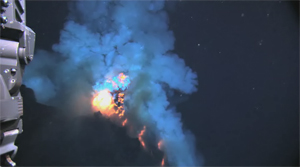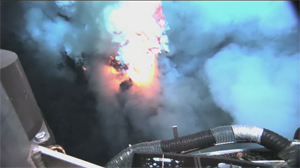
Imagery includes large molten lava bubbles approximately three feet across bursting into cold seawater, glowing red vents explosively ejecting lava into the sea, and the first-observed advance of lava flows across the deep-ocean seafloor. Sounds of the explosive eruption were recorded by a hydrophone and later matched to the video footage.
"We found a type of lava never before seen erupting from an active volcano, and for the first time observed molten lava flowing across the deep-ocean seafloor," said the mission's Chief Scientist Joseph Resing, a chemical oceanographer at the University of Washington who collaborates with NOAA through the Joint Institute for the Study of the Atmosphere and Ocean. "Though NOAA and partners discovered a much shallower eruption in 2004 in the Mariana Arc, the deeper we get, the closer the eruption is to those that formed most of the oceanic crust."

Download as Quicktime: Video 2
Mission scientists released the video and discussed their scientific observations at a Dec. 17 news conference at the American Geophysical Union's annual fall meeting in San Francisco.
"For the first time we have been able to examine, up close, the way ocean islands and submarine volcanoes are born," says Barbara Ransom, program director in NSF's Division of Ocean Sciences. "The unusual primitive compositions of the West Mata eruption lavas have much to tell us."
The West Mata volcano is producing Boninite lavas, believed to be among the hottest erupting on Earth in modern times, and a type only seen before on extinct volcanoes older than a million years. University of Hawaii geochemist Ken Rubin believes this active Boninite eruption provides a unique opportunity to study magma formation at volcanoes and how the Earth recycles material where one tectonic plate is subducted under another - a long-term goal of many Earth scientists.
Water from the volcano is very acidic, with some samples collected directly above the eruption measuring somewhere between battery acid and stomach acid. Julie Huber, a microbiologist at the Marine Biological Laboratory, found diverse microbes even in such extreme conditions.
Tim Shank, a biologist at the Woods Hole Oceanographic Institution (WHOI), found shrimp were the only animals thriving in the acidic vent water near the eruption. Shank is analyzing shrimp DNA to determine if they are the same species as those found at eruptive seamounts more than 3,000 miles away.
Mission scientists believe 80 percent of eruptive activity on Earth takes place in the ocean, and most volcanoes are in the deep ocean. Until this discovery, NOAA and NSF had sponsored research on submarine volcanoes for 25 years without observing a deep-ocean eruption. Scientists believe further study of active deep-ocean eruptions will provide a better understanding of oceanic cycles of carbon dioxide and sulfur gases, how heat and matter are transferred from the interior of the Earth to its surface, and how life adapts to some of the harshest conditions on Earth.
The science team operated from the University of Washington's research vessel Thomas Thompson, and deployed Jason, a remotely-operated underwater robot operated by WHOI that is recognized as one of the most capable in the world. Jason collected samples using its manipulator arms and obtained imagery using a prototype still and HD imaging system developed and operated by the Advanced Imaging and Visualization Lab at WHOI.
Other participants included Oregon State University, Monterey Bay Aquarium Research Institute, Western Washington University, Portland State University, Harvard University, the University of Tulsa, California State University's Moss Landing Marine Laboratory, the University of California Santa Cruz and Lamont Doherty Earth Observatory.
The National Science Foundation is an independent U.S. government agency responsible for promoting science and engineering through research programs and education projects.
NOAA understands and predicts changes in the Earth's environment, from the depths of the ocean to the surface of the sun, and conserves and manages our coastal and marine resources.
Video 1:
This is a sequence of explosive degassing events as bubbles of gas- rich magma burst, spewing lava fragments into the water. At same time, lava is being extruded out of the vent and down the slope. The area in view is about 6-10 feet across in an eruptive area approximately 100 yards that runs along the summit. Courtesy of National Science Foundation and NOAA.
Video 2:
This spectacular sequence is a closer view of the eruption with violent magma degassing events producing bright flashes of hot magma. Lava is blown up into the water before settling back to the seafloor, and large plugs of lava flow rapidly down the slope. In the foreground is the front of the Jason remotely-operated vehicle (ROV) with sampling hoses. The area in view is about 6-10 feet across in an eruptive area approximately 100 yards that runs along the summit. Courtesy of National Science Foundation and NOAA.
 Explosion near summit of West Mata volcano throws ash and rock. Molten lava glows below. Image is about six feet across in an eruptive area about 100 yards that runs along the summit. High resolution (Credit: NOAA and NSF) |
 Hot magma blows up into the water before settling to the seafloor. Foreground: Jason remotely-operated vehicle with sampling hoses. Image is about 6-10 feet across in an eruptive area about 100 yards that runs along the summit. High resolution (Credit: NOAA and NSF) |
 Orange glow of magma is visible on left of sulfur-laden plume. Image is about six feet across in an eruptive area about 100 yards that runs along the summit. High resolution (Credit: NOAA and NSF) |
 Jason remotely-operated vehicle samples fluid at an eruptive area near the summit of the West Mata Volcano. The fluid sampling "wand" is about three feet long. High resolution (Credit: NOAA and NSF) |
 Summit of West Mata Volcano, shown in red, is nearly a mile below the ocean surface (1,165 meters / 3,882 feet), and the base, shown in blue, descends to nearly two miles (3,000 meters / 9,842 feet) deep. Eruptions occurred at several places along the summit, in an area about 100 yards. The volcano has a six-mile-long rift zone running along its spine in a SW/NE orientation. High resolution (Credit: NOAA) |
 West Mata Volcano (white ellipse on bathymetric map) is not the largest volcano in the northeast Lau Basin, but appears to be the most active. Map represents the area visited and mapped on two recent expeditions. Summit of West Mata Volcano is nearly one mile deep, the base is nearly two miles deep. Tonga Trench (north and east of the expedition area) is nearly seven miles deep. High resolution (Credit: NOAA) |
 West Mata Volcano, in the Lau Basin, is located in the southwest Pacific, within an area bounded by Samoa, Tonga and Fiji (the black areas on the map, which are the only areas above water). Area is home to many submarine volcanoes. High resolution (Credit: NOAA) |
 Superheated molten lava, about 2,200 degrees Fahrenheit, is about to explode into the water in this image. The area in view is about 6-10 feet across in an eruptive area approximately the length of a football field that runs along the summit. High resolution (Credit: NOAA and NSF) |
 Bands of glowing magma, about 2,200 degrees Fahrenheit, are exposed as a pillow lava tube extrudes down slope. Image is about three feet across in an eruptive area about 100 yards that runs along the summit. High resolution (Credit: NOAA and NSF) |
 Close-up view of the shrimp at summit of West Mata Volcano. May be the same species as those found at eruptive sites more than 3,000 miles away. High resolution (Credit: NOAA and NSF) |



Reader Comments
to our Newsletter